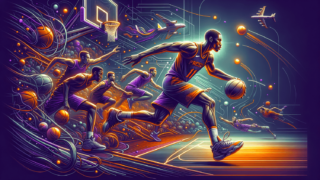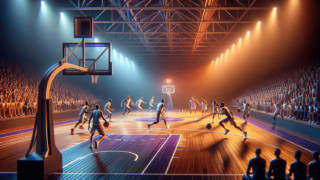
How to Improve Your Basketball Screening Techniques?
Written by: Basketball Universe
Last updated:

Whether you’re a seasoned baller or a newbie to the court, mastering the art of basketball screening techniques is crucial to elevating your game. It’s like a behind-the-scenes enabler, setting the stage for your teammates to shine, while also becoming a pivotal playmaker! This fun, yet professional blog post will explore various tips and tricks that will equip you with the knowledge you need to become an unyielding, effective screen-setter. So, lace up your sneakers and let’s dive into the world of screens, picks, and rolls, discovering the tactics that will complement and enhance the skills of both you and your teammates. It’s time to reach new heights on the court!
How to Improve Your Basketball Screening Techniques?
To improve your basketball screening techniques, focus on the following: 1) perfecting your timing to set the screen just as your teammate’s defender approaches; 2) maintaining a sturdy and balanced stance with feet shoulder-width apart and arms bent slightly; 3) positioning yourself between the ball handler and their defender for maximum effectiveness; 4) communicating with your teammate to ensure a well-coordinated play; and 5) practicing various types of screens such as the on-ball, off-ball, and back screens to expand your skillset and adapt to different game scenarios.
Mastering the Art of Timing Your Screens
Screening successfully in basketball is heavily reliant on your ability to time your screens correctly. When setting a screen, ensure it meshes seamlessly with your teammate’s movements to create those open opportunities on the court. As you improve your timing, you’ll develop a stronger bond with your teammates, discover their unique quirks, and enhance your overall performance. Keep in mind that good timing will help prevent offensive fouls and ensure cleaner pick-and-roll plays. To perfect your timing, invest in practice, game-like simulations, and establishing a clear line of communication with your team.
Know Your Teammates’ Tendencies
A successful basketball team has players who are in sync with each other. To set effective screens, you must pay attention to your teammates’ tendencies and playing styles. This insight will help you build chemistry and better understand when and where to set screens based on their individual strengths. Observe shooting preferences, favorite spots on the court, and driving habits. This crucial information will help you prepare to set more effective screens, positioning yourself to optimize each opportunity.
The Fundamentals of an Effective Stance
An ideal screening stance involves a strong, balanced foundation that protects you from defensive pressure while allowing you to stay agile enough to make your next move. This section will guide you through the keys to achieving a powerful, effective stance when setting a screen in basketball.
Feet Positioning
Position your feet about shoulder-width apart to establish a solid base. Square your feet towards the direction of the oncoming defender to prevent getting pushed off-balance or committing a foul. Slightly bend your knees and lower your center of gravity, which will help increase your stability against defensive pressure.
Arm Positioning
Place your arms close to your body with elbows bent and hands clasped in front of your chest or abdomen. This prevents defenders from slipping through and keeps your limbs shielded from illegal contact. Make sure not to extend your arms or elbows outward, as this could lead to an offensive foul.
Body Contact with the Defender
While setting the screen, avoid pushing or leaning into the defender’s body. This is critical in steering clear of offensive fouls. Instead, maintain your stable stance and invite the defender to run into your screen, which provides a safer and more effective outcome.
Proper Screen Positioning and Techniques
The success of a screen is not just about timing and stance but also about setting the screen at the right position. In this section, we’ll focus on key factors in positioning your screen that boost your chances of success on the basketball court.
On-Ball Screens (Picks)
On-ball screens, or picks, are crucial to opening up space for dribblers. To set a successful on-ball screen, position yourself such that you’re between the ball handler and their defender. Make sure adequate space exists between you and the ball handler so they can use the screen without getting trapped by their defender. Also, maintain a distance that doesn’t provide opposing defenders an opportunity to switch and easily recover, thus maintaining offensive pressure.
Off-Ball Screens
Off-ball screens help your teammates without the ball create separation and scoring opportunities. Focus on creating the right angle and position, enabling your teammate to either channel their defender into your screen or force the defender to fight through the screen. The objective is to slow down the defender and generate an open look for running or shooting. Awareness of spacing and legal guarding positions are essential to avoid illegal screens and offensive fouls.
Back Screens
A back screen occurs when an off-ball player sets a screen behind a defender, enabling their teammate to cut toward the basket or position on the court. These are especially effective in catching defenders off-guard and creating opportunities for alley-oop plays or open shots. Position your body behind the defender’s line of sight, while maintaining enough distance from your teammate, ensuring the screen is well-executed and within legal limits.
Clear Communication with Your Teammates
Effective screens require proper communication with your teammates, both verbally and non-verbally. Sharing information and signals with your team will help you maximize offensive efficiency and make the most out of every basketball play.
Verbal Communication
Let your teammate know when you are setting a screen by using designated words and phrases. Avoid revealing your intentions to the defender as much as possible. Some teams opt for subtle cues like code names to make their screens unpredictable. Practice these cues and incorporate them into your game to enhance team dynamics and decision-making on the court.
Non-Verbal Communication
Non-verbal cues with your teammates are equally important when setting screens. You can use hand signals or specific body movements to indicate your intentions while avoiding alerting the defense. Implement these techniques during practice and game situations to build a strong understanding with your team and become a formidable screening machine.
Variety of Screening Techniques to Keep Defenders Guessing
A great basketball player knows the value of versatility. By adding multiple screening techniques to your repertoire, you not only keep defenders on their toes but also create new opportunities for your teammates. Let’s dive into several types of screens and how to execute them effectively.
Pick-and-Roll
In a pick-and-roll, the screen-setter creates space for their teammate before rolling to the basket for a potential pass. After setting a strong screen, plant the foot closest to the basket and quickly pivot towards the hoop, ensuring you maintain legal contact with the defender. Establish a target for the ball handler by extending your hands and maintaining eye contact. This method creates confusion among defenders and opens up multiple scoring possibilities.
Pick-and-Pop
The pick-and-pop play involves setting a screen and then moving out to an open space on the court for a potential jump shot. This works best when the screen-setter is a proficient mid-to-long-range shooter. After setting the pick, identify an open spot on the court and quickly relocate, readying yourself to catch and shoot. Both pick-and-roll and pick-and-pop are interchangeable in a game, making it harder for the defense to predict your moves.
Slip Screen
A slip screen is a deceptive play in which the screener quickly “slips” towards the basket without actually setting the screen. This play capitalizes on overzealous defenders who anticipate and adjust for a traditional pick-and-roll or pick-and-pop. To execute a slip screen, anticipate the defender’s movements and cut towards the hoop as the ball handler initiates their drive, creating a scoring opportunity that can catch defenses off-guard.
Bringing It All Together: Basketball Screening Mastery
Screening in basketball is a skill that requires precision, timing, and communication. Improve your craft by learning and practicing various screening techniques. Equip yourself with knowledge of optimal positions for screens, fine-tune your stance, and develop a strong rapport with your teammates on and off the court. Remember that success in basketball is collective, and your growth as a screener will contribute to your team’s victory. So get out there, set bone-rattling screens, and help your teammates create dazzling on-court moments!
Enhancing Your Basketball IQ and Studying the Opposition
Improving your basketball screening techniques goes beyond your physical skills and execution. Developing a keen understanding of game situations, strategies, and opponents is paramount for a player to improve their screening efficiency. In this section, we will explore the mental aspect of setting a screen and provide valuable tips to enhance your basketball IQ.
Understand Different Offensive Sets and Situations
Each basketball team has its unique playbook and style. To become an effective screener, familiarize yourself with your team’s offensive sets and identify where screens can be best utilized within these sets. By adapting your game to your team’s offensive schemes, you maximize your effectiveness on the court, making it difficult for the defense to contain or predict the next move.
Analyze Your Opponents
Knowing your opponents is an essential aspect of setting effective screens. Study the strengths and weaknesses of individual defenders and analyze how the opposing team usually reacts to screens. Understanding their tendencies and habits can help you anticipate their movements, allowing you to set better screens and create scoring opportunities for your team.
Physical Conditioning and Agility Training
Training your body to withstand the physical demands of setting screens is critical to becoming an efficient player. This section discusses the importance of physical conditioning and shares some useful exercises to enhance your stamina, strength, and agility on the basketball court.
Endurance Training
Setting effective screens requires stamina and endurance, as it often involves constant movement, contact, and change of direction. Invest time in endurance training to increase your cardiovascular fitness, allowing you to keep up with the game’s pace and set more powerful screens. Include exercises such as running, swimming, and interval training in your routine to elevate your conditioning.
Strength Training
Effective screens demand physical strength to resist defensive pressure and maintain balance. Incorporate strength training in your workout routine to improve your overall physical prowess. Focus on exercises that target your core, lower body, and upper body, such as squats, lunges, deadlifts, and bench presses. This will enable you to effectively withstand contact and maintain a solid base when setting screens.
Agility Training
Agility is vital when setting screens and reacting to opponents’ movements. Enhance your agility with exercises that target footwork, change-of-direction, and balance, such as ladder drills, cone drills, and plyometric exercises. Improved agility benefits not only your screening techniques but also your overall performance as a basketball player.
Learning from the Pros: Studying Professional Basketball Players
One of the best ways to improve your basketball screening techniques is to learn from those who have mastered the art. Observe and analyze professional basketball players who excel in setting screens, and emulate their techniques and methods in your game.
Watch Game Footage and Highlights
Study footage of renowned basketball players who effectively set screens, such as Draymond Green, Al Horford, and Steven Adams. Observe their stance, positioning, and timing when setting screens. Analyzing these pros in action can provide valuable insight into techniques that can elevate your performance.
Focus on Screen-Setting Specialists
Several professional basketball players have built their careers on setting outstanding screens. Pay close attention to their screen-setting techniques, communication with teammates, and overall attitude towards screening. By taking cues from these specialists, you can learn valuable lessons that will help you become a more effective and efficient screener in your own team.
By incorporating the above-discussed elements, you are well on your way to becoming a highly skilled screener. Remember that constant practice and dedication are essential for reaching your full potential. As you hone your screening techniques, you’ll contribute significantly to your team’s success and elevate your game to new heights!
Frequently Asked Questions
Here are some common questions about setting screens and improving basketball screening techniques. These FAQs provide quick answers to help you bolster your knowledge and implementation of various screening techniques, further elevating your performance on the court.
1. Why is screening important in basketball?
Screening is important in basketball because it helps create open spaces and opportunities for teammates to score or make plays. It adds an element of unpredictability to an offensive set, making it more challenging for the defense to anticipate and counteract offensive movements.
2. How do you avoid offensive fouls when setting screens?
To avoid offensive fouls when setting screens, ensure you maintain a balanced stance without leaning or pushing into defenders. Keep your feet shoulder-width apart, and hold your arms bent and close to your body. Always establish a legal guarding position before setting screens, and be mindful not to move or initiate illegal contact with defenders.
3. How can I improve my communication with teammates when setting screens?
Improve your communication with teammates by incorporating verbal cues or code names for screens, as well as using non-verbal cues such as hand signals and specific body movements. Practice these methods regularly with your teammates during team training sessions and games to foster better understanding and synchronization on the court.
4. How can I become a more versatile screener?
To become a more versatile screener, learn, practice, and perfect various screening techniques such as the pick-and-roll, pick-and-pop, slip screen, and adaptive off-ball screens. Implement these techniques during game situations, stay alert to opportunities, and adjust your movements based on your teammates’ requirements and the defensive scenario.
5. How can I improve timing for optimal screen effectiveness?
Improve your timing for optimal screen effectiveness by studying your teammates’ tendencies and playing styles, anticipating their movements, and being ready to set screens at the right moment. Practice game-like simulations and develop a clear line of communication with your teammates to refine your timing.
6. What is the proper way to set a legal screen?
To set a legal screen, maintain a stationary position with your feet about shoulder-width apart, knees slightly bent, and your arms bent and close to your body. Establish your position before the defender makes contact, ensuring that you don’t initiate the contact or move while setting the screen.
7. How should I position myself when setting an off-ball screen?
When setting an off-ball screen, position yourself such that you create the right angle to channel the defender into your screen or force them to fight through the screen. Ensure adequate spacing between you and your teammate, maintain awareness of legal guarding positions, and be ready to adapt based on your teammate’s movements.
8. How can physical conditioning benefit my screen-setting abilities?
Physical conditioning benefits your screen-setting abilities by building strength, endurance, and agility needed to withstand defensive pressure, maintain balance, and react quickly to game situations. Include endurance, strength, and agility exercises in your workout routine to enhance your overall performance as a screener.
9. How can I improve my basketball IQ to become a better screener?
Improving your basketball IQ involves understanding your team’s offensive sets, identifying where screens can be most effective, and studying individual defenders and opposing teams’ habits. Regularly watch game footage of professional basketball players and analyze their screen-setting techniques to further develop your knowledge and understanding of basketball screening.
10. How do I decide when to use a pick-and-roll or a pick-and-pop?
The decision to use a pick-and-roll or a pick-and-pop will depend on the game situation, your teammates’ strengths, and your individual skill set. A pick-and-roll is suitable if you excel in cutting to the basket and finishing at the rim after setting a screen. A pick-and-pop works well if you are a proficient mid-to-long-range shooter who can relocate to an open spot and execute a catch-and-shoot play. Being versatile and adapting to game situations will help you make the best decision on when to use these techniques.
Featured Posts
- No pillar pages found.





